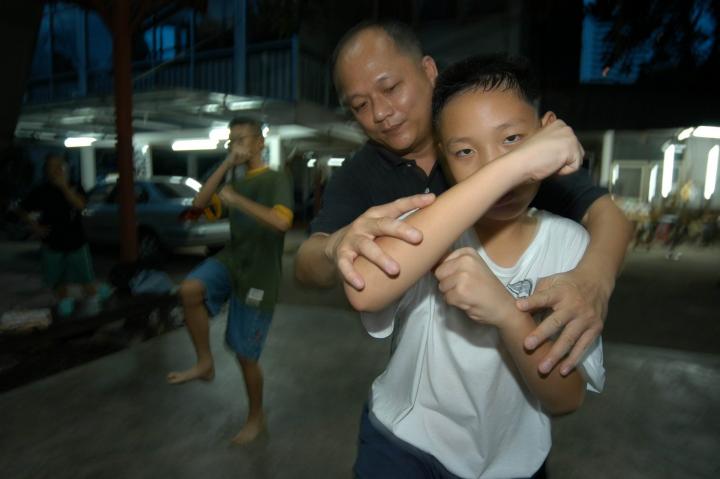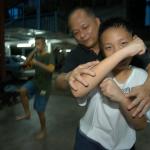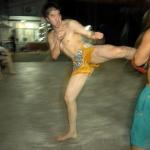Martial Artistry
On the back wall of Kridakorn "Lek" Sodprasert's boxing studio are portraits, in descending order, of a revered monk, Their Majesties the King and Queen, and his first two kickboxing instructors.
He met the second teacher at the funeral of the first one. After asking if he could study with him, the teacher demanded that Lek punch him in the face. He took a swing, but the instructor blocked it, and punched him twice in the mouth, bloodying his lips. Right then and there, Lek decided that this man was to be his new mentor in one of Thailand's oldest and most significant martial arts - Muay Chaiya.
"He was a very kind person, but very violent too," says Lek.
No doubt some of Lek's students at his al fresco boxing gym on Sukhumwit Soi 63 would make the same contradictory claims about him. For the last eight years he's been schooling both Thais and a lesser number of Farangs in this ballet of brutality and self-defense at his stronghold of Ban Chang Thai. The classes consist of two-hour sessions held Friday and Saturday night. And the students range from little hellions, whose parents want to instill some discipline in them, to young women learning ways to ward off would-be rapists, to some very bloody-minded students hoping to become professional pugilists, and a sprinkling of older gents trying to keep a few laps ahead of the wheelchairs-and-walkers brigade.
Kridakorn says that this regional school of Thai boxing combines military-like discipline with the teachings of Buddhism - a combination of violence and kindness that seems fitting given its origins. Some 250 years ago a soldier from Bangkok named Por Tan Mar (hearsay has it that a stillborn coup was the catalyst for his departure) fled to a temple in the town of Chaiya in Surat Thani province. The soldier then ordained as a monk. At Wat Tung Jab Chang he forged a new hybrid of older fighting styles, heavy on defensive postures. Since the fighter must constantly be ready to block punches and kicks with his elbows and knees, which are always slightly bent, even when going on the attack, this style has been likened to the spiky armour of the durian.
Khru Lek is also a successful artist, creating traditional dolls, puppets, and mystical artworks coloured by the Buddhist canon, and scenes from Thai folklore. In his house, beside the outdoor boxing studio, he has an astonishing array of his work in glass cases, and much of his work, like masks for Thai traditional dramas of yore, are snapped up for decent prices by the crème de la crème of Thailand's business and artistic elite. Given his background, and all-round creativity, Lek is drawn to the artistic side of Muay Chaiya: the tiger-like leaps and the fluid footwork.
"It's not like Muay Thai. That's a ring sport," says the 49-year-old divorcee, who has yet to propagate the species. "And nowadays Muay Thai is all about scoring points and big, flashy kicks. It's about winning and making money. But Chaiya is derived from battlefield styles and street fighting."
As he is quick to demonstrate - amazingly quick for a short, balding man whose paunch points out that he hasn't missed too many mealtimes - the Chaiya School of boxing has loads of dirty tricks. Like jabbing your fingers into an opponent's eyes. Like kicking him between the legs.
Then he shows us how to defend one's self against a knife-wielding attacker. A student comes at him, using a mobile phone in place of a switchblade. He lunges at Lek like a fencer. The teacher blocks the surrogate weapon with his left forearm, spins around and side-kicks him in the knee, and before the mind can explain what the eye has seen, he's disarmed the attacker.
Pointing to his forearm, the teacher says, "In this kind of street-fighting, you're going to get hurt. So you have to be brave."
Though he's never fought professionally, has Lek ever been baited into a barroom brawl? Or just felt like showing off his training techniques by inflicting a gratuitous beating on some poor schlep passing by?
"When I was younger I was quite hot-tempered, so I've been in a few scraps. One night, about 12 years ago, when I was living in Thonburi, there was a car full of Indians driving around, harassing street vendors and then they parked in front of my house. I told them they to calm down a little. So they hurled insults at me and then all four of them got of the car along with a woman. The men were quite big, but I knocked two of them out and then the other two ran away and the woman fainted," laughs Lek, who comes from an eclectic family of Bohemians: an architect father from Bangkok, a jewellery-making mother from the gem-rich province of Chantaburi, and his brother is a classical guitarist of note.
What he relishes the most about being a ring-leader is bequeathing genuine Thai traditions to a new generation Lek figures are being led astray by non-Thai influences. In class, he comes across as stern at times, putting as much emphasis on the grace of the movements, as the accuracy of the punches and kicks, during the repetitive line drills. But there are moments of levity. When one of the young boys has stepped way out of line, and is joking around with his two friends, Lek picks him up by the armpits, carries him back to his proper place and puts him down again. He smiles at the boy while all the other students laugh.
At the end of the class, the teacher and his charges kneel down to pay obeisance to the monarchy, the Buddhist clergy, and Lek's two old boxing teachers. Then they stand up. As the students begin talking, and he thinks no one is watching, Lek walks over to straighten the portrait of his kind and violent mentor in Muay Chaiya.
* * *
The cost is Bt2,400 for three classes of two hours each. Contact Lek at banchangthai@yahoo.com.
* * * * *
 ThingsAsian
ThingsAsian


















